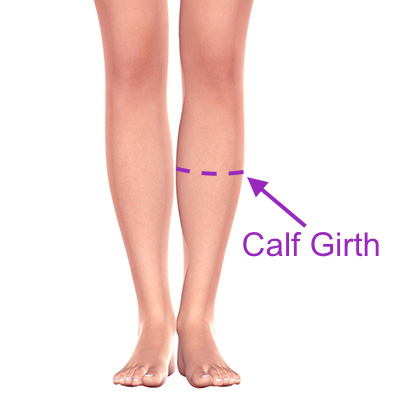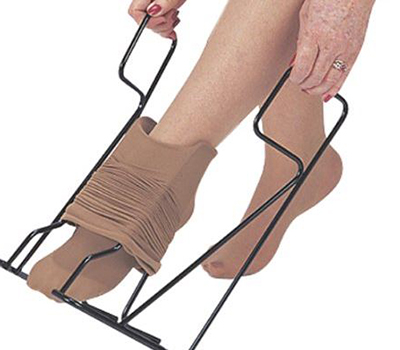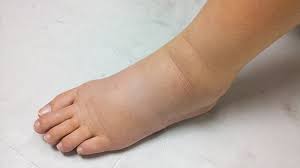What Do Compression Socks Help Swollen Ankles
Last Updated December 29, 2021

Looking to Buy a Pair of properly-sized Compression Socks?
Click the button below to see the lineup of ComproGear Compression Socks.
NOTE: The page includes a sizing chart and free returns, so you're always sure to get the perfect size!
Many people already know that compression socks and stockings help people with varicose veins, but how do compression socks work for swelling problems in the feet and ankles? How do they affect your overall health?
These specially-designed garments are meant to be worn tightly around the legs and feet. When worn, they apply a level of pressure needed to push excessive fluids out of our legs, ankles, and feet — which take form visibly as varicose veins — or swollen feet and ankles in milder cases.
We will learn more about what compression socks do, who uses them, and the many wellness benefits that wearing a pair will bring you!

What are compression socks?

If you think of compression stockings as tight-fitting stretchy socks that squeeze your legs, you aren't far from the truth.
Meanwhile, graduated stockings, sometimes called pressure stockings, give your ankle a tighter fit. The pressure it exerts on your legs is gradually reduced as the garment reaches the upper parts of your leg.
Compression sleeves resemble your socks but with both ends cut off, allowing them to be worn even in one's arms.
Compression socks and stockings are designed to control swelling around the ankles, feet, and legs by applying pressure on them. This action prevents fluid buildup in the tissues that can cause discomfort or possibly even pain. The pressure can have different levels, and your doctor can tell you which will suit you best.
They also come in different sizes and lengths, and as you wear them, you'll learn what works best for you.
Monitor and examine your legs as you wear them. If you notice any side effects, remove them immediately and consider seeking medical attention. These side effects can include:
- Pain, numbness, or a prickling sensation in the area of your feet or legs
- Change in your feet and leg's appearance or temperature
- A wound has developed in the area covered by the compression socks
Who uses them?
Depending on the situation, many people find relief in using compression socks due to their versatility and many uses, including:
- People who have problems with circulation like diabetes or varicose or at risk of developing such ailments.
- People who recently underwent surgery.
- People who have difficulty moving or can't get out of their bed.
- People whose jobs require standing for long hours.
- Athletes.
- Pregnant women.
- People who sit for long hours in airplanes, like pilots, for instance.
Why – and how – they work
These specially-designed stockings apply pressure on your legs and function to improve the circulation of your blood vessels. Your arteries, which carry oxygen-rich blood, relax, allowing blood to flow without obstruction. Meanwhile, the same pressure helps your veins guide and push blood back to your heart.
The result — your feet and ankles are less prone to swelling. This explains why wearing these garments also lessens the stress on your legs, which helps keep them from getting weary quickly.
With blood circulation much improved, the constant flow of blood prevents it from pooling in your veins and consequently may prevent blood clots. At the least, these clots can result in problems like swelling and skin discoloration. At worst, it can result in life-threatening medical issues and even heart failure.
Athletes like basketball players, sprinters or triathletes, also benefit from the use of compression sleeves and socks.
Recent studies have shown that while the effect on athletic performance is almost negligible, compression therapy works well in aiding muscle recovery.
Not all compression socks are equal!

There are a variety of socks and sleeves available in the market. Besides the fabric and design, they can vary in length, which addresses different needs and requirements.
Stockings are also available in different pressure or compression levels, which are measured in millimeters of mercury (mmHg). Ideally, stockings should be tight-fitting but not cause any pain in the legs or feet.
Compression socks classified as mild, which have lower mmHg reading, are sufficient for everyday use and helps keep your feet comfortable while you're at work, for example.
Meanwhile, if you're on your feet most of the day but you're mobile, your best option is a pair of graduated compression socks.
However, there will be cases when you may need to use garments with a higher, medical-grade classification or level. They should give you a tighter fit and prevent the progression of DVT, for example.
Compression socks like anti-embolism stockings are made specifically for patients who have just undergone surgery and require bed rest.
If you wear socks for medical reasons, your doctor will measure your legs and prescribe the most appropriate socks for you.
Whichever you choose, your reason for wearing them determines which one is best for you.

Looking to Buy a Pair of properly-sized Compression Socks?
Click the button below to see the lineup of ComproGear Compression Socks.
NOTE: The page includes a sizing chart and free returns, so you're always sure to get the perfect size!
How to wear them
Once you've chosen your compression socks, you also need to wear them properly. This ensures their effectiveness and prevents complications.

Some tips on wearing your compression socks
- Don't roll or fold your compression socks into a bunch. This makes your garment too tight, which can hinder blood circulation.
- Buy the correct length you need – neither too long nor too short.
- As you're putting your garment on, smooth it out and make it lay flat (no wrinkling!) against your skin.
- Jewelry and your garment don't mix well. Take them off. They can snag and cause tears in your garment while putting them on.
- Start by pulling your socks up the heel, then the leg. You can wear rubber kitchen gloves to help with your grip.
- To preserve your garment, don't pull on the tops too much.
- You can usually wear your socks as often as needed. If it's medically prescribed, follow your doctor's orders.
- Remove them while bathing or in the shower.
- You can wear your regular footwear – including regular socks – with compression socks and sleeves.
- There are special equipment and gadgets sold in the market to help you wear them and get them off.

Step-by-step guide
As you incorporate wearing the garments into your regular routine, it's helpful to know the best way to put them on and off.

- Start by turning the upper half of your compression socks inside out. Reach in and pull the toe of the sock towards you.
- Gently put your foot into the garment with the toe first, then slide your heel into place. Ensure that the upper half of the stocking is still inside out.
- Slide the rest of the garment up your calf and adjust the fabric into place. Do this gently.
- Avoid pulling your compression socks into place by pulling them at the top of the sock. You won't want to create tears or make the fabric lose its stretch.
- To remove your stockings, gently pull the top so that the garment is loosely bunched up at the ankles.
- Insert your thumb near the heel, pull the stockings off from the heel first, then slide it off from the rest of your foot.
Types of compression stockings
The are three major types:
- Graduated compression stockings
- Anti-embolism stockings
- Non-medical support hosiery
Graduated Compression Stockings
Compression levels are strongest around the ankle in graduated compression socks, with the tightness increasingly loosening further up towards the top end.
With specified length and strength to treat various medical conditions, they typically require fitting by a professional.
Stockings that stop below the knee prevent fluid accumulation (which leads to edema) and reduce swelling in the lower leg. Those that reach the waist or thighs reduce blood pooling and prevent orthostatic hypotension.
Anti-Embolism Stockings
These stockings help reduce the risk of developing deep vein thrombosis and also provide gradient compression. The compression levels differ, however, and these are often used by immobile people.
Non-Medical Support Hosiery
This type does not usually require a prescription and includes flight socks and elastic support socks that provide relief for weary, aching legs.
They also deliver uniform compression, exerting less pressure on the legs than prescription compression stockings.
Reminders on some possible side effects
If your doctor prescribed your compression stockings, check for any notable changes such as skin irritation, sores, or redness. These side effects could indicate:
- A poor fit
- An infection
- Improper donning or removal of your compression socks or stockings
- Allergies to the material used in the manufacture of the socks or stockings
If the symptoms persist, get medical advice as soon as possible. Your doctor will provide medical advice on the proper usage of these garments.
6 quick hacks to treat painful, swelling feet and ankles

Have you ever looked down at your feet and barely recognize them because they are swollen? This typically occurs after a long trip, sitting or standing for too long, being pregnant, or after undergoing surgery.
Swelling around the feet and ankle can cause discomfort and can often hinder movement.

Looking to Buy a Pair of properly-sized Compression Socks?
Click the button below to see the lineup of ComproGear Compression Socks.
NOTE: The page includes a sizing chart and free returns, so you're always sure to get the perfect size!
Nevertheless, this retention of fluids in one or both of your ankles, feet, and legs can be relieved and prevented and often not a cause for serious alarm. Treatment is frequently so simple that you can even do it yourself. Here are a few tips to help you.
Wear Compression Socks
This is a very convenient solution if you're unable to follow the other suggestions on this list. Easily purchased at an online store or over the counter at a pharmacy, they can help relieve pain and prevent fluid buildup in your ankles, feet, and legs.

They come in different weights, including light, medium, and heavyweight. Get one that is comfortable and fits snugly.
Elevate Your Legs
Put your legs up on a footstool or coffee table. Pile some pillows and put your legs on top of them as you lie in bed.
Exercise
Standing or sitting for an extended period builds up fluid in the legs and lower extremities. These habits are just not healthy for you. Relieve your lower extremities by doing simple exercises while seated or standing. Move your knee and thighs, extend your ankles, and flex!
Lose Weight
Go on a diet because weight loss also helps. Moreover, it's good and healthy for you!
Use Epsom Salt
Run a warm bath and fill the tub with Epsom salt. Soak your legs in this bath for about 15 to 20 minutes. This relieves you of pain and swelling without the expensive prescription medications. If you experience diabetic neuropathy on your feet, use your hands to check the water and avoid exposing your feet to harsh temperatures.
Take Magnesium Supplements
Add 200 to 400 mg of magnesium as a diet supplement. This may help limit your water retention and reduce pain. Healthy or not, while these are not prescription medications, consult your doctor, though, before you start any treatment.
Other healthy, simple changes you can do
To get even better results, try the aforementioned therapies in combination. A good start would be to take up walking as an exercise and use compression socks while doing it.

Making minor adjustments to your lifestyle can also help. These simple adjustments can include:
- Taking a quick stroll or walk every hour.
- Drinking water regularly, about 8 to 10 glasses per day, keeps you hydrated and helps flush out toxins.
- Limiting your consumption of carbohydrates and salt.
Try using essential oils like eucalyptus oil, peppermint oil lavender, or chamomile. They've been known to give soothing relief and good for your overall health and wellness.

Looking to Buy a Pair of properly-sized Compression Socks?
Click the button below to see the lineup of ComproGear Compression Socks.
NOTE: The page includes a sizing chart and free returns, so you're always sure to get the perfect size!
What Do Compression Socks Help Swollen Ankles
Source: https://comprogear.com/answered-how-do-compression-socks-work-for-swelling/
0 Response to "What Do Compression Socks Help Swollen Ankles"
Post a Comment